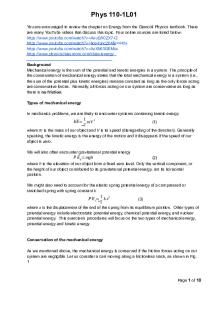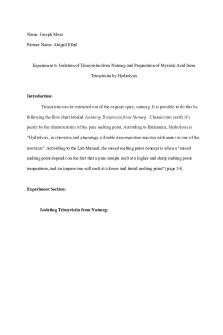Lab 5 Report with graph PDF

| Title | Lab 5 Report with graph |
|---|---|
| Author | Tevin Renken |
| Course | Physics I Lab |
| Institution | Emporia State University |
| Pages | 4 |
| File Size | 167 KB |
| File Type | |
| Total Downloads | 57 |
| Total Views | 134 |
Summary
Lab report with graph ...
Description
Point Charge Lab 07 February 2017 PH 344 B I certify that the contents of this report are my original work
Statement of Problem
What’s the dependence of the electrostatic potential on the distance from the point charge? Can lines of equal be drawn for a point charge? I believe that after experimentation, the dependence of electrostatic potential and lines of equal potential can be determined. Description of Experiment For this experiment, measure the potential difference between the electrodes on the paper. Keeping the voltmeter lead on the negative electrode, place the other lead at various points on the black paper, to find curves of equal potential. Transfer those points onto a drawing on a blank sheet of paper. Secondly, take readings of the voltage every 1 cm as you move away from the point charge to the outer circle. Make a graph of V vs. r and a graph of V vs. LN(radius). Data Radius (cm) 1 2 3 4 5 6 7
Voltage (V) 5.05 7.37 8.22 8.95 9.55 10.19 10.69
Results Graphical analysis was conducted on the data collected. A graph of volts vs. radius was created, showing the “potential hill” produced by the charge at the central point. The equation for that line was y=2.8001ln(x) + 5.164 with an R2 value of 0.994. Another graph of volts vs. ln(radius) was created producing an equation that would allow for the values of A and B to be found from the following equation V=Blnr + A. The equation of the graph was y=1.088x+1.6878 with an R2 value of 0.84. From that graph the values of B and A were determined to be 1.088 for A and -0.23. V=Blnr + A Figures
Voltage vs. Radius 12 10
f(x) = 2.8 ln(x) + 5.16 R² = 0.99
Voltage
8 6 4 2 0 0
1
2
3
4
5
6
7
8
Radius (cm)
A plot of charge (V) as a function of radius (cm) yields a plot where the curve represents the “potential hill” produced by the charge at the central point.
Voltage vs. ln(Radius) 2.5 f(x) = 0.11 x + 1.69 R² = 0.85
Voltage
2 1.5 1 0.5 0 0
1
2
3
4
5
6
7
8
ln Radius (cm)
A plot of charge (V) as a function of ln(radius) yields a plot where the slope can be used to determine the values of A and B from the following equation, V=Blnr + A. Conclusion As a result of the experiment, it can be seen that lines of equal potential can be drawn and they form concentric circles. Also, the constant values of A and B can be determined from the above equation, when using the graph of volts vs. ln(radius). The Values of A and B are determined to be 1.088 and -0.23. Potential sources for error in this experiment could come from the fact that it was very hard to get to the wire attached to the negative lead because it was covered in a glob of glue, so if the wire was more exposed, more accurate data could have been taken. Also, if a higher voltage
was used for the drawing of the equal potential lines, more values could have been taken, which would created more concentric circles....
Similar Free PDFs

Lab 5 Report with graph
- 4 Pages

Lab 8 Report with graph
- 3 Pages

LAB 5 - Lab report
- 4 Pages

Lab Report 5 - lab
- 5 Pages

Lab 5 - Lab report
- 6 Pages

Lab 5 - Lab experiment report
- 6 Pages

Lab 5 Lab Report- (Microbiology)
- 4 Pages

Phys lab 5 - Lab report
- 10 Pages

Experiment 5 - Lab Report 5
- 16 Pages

Post Lab Report Lab 5
- 5 Pages

Lab 5 Report
- 5 Pages

Chem lab report 5
- 7 Pages

Lab 5 Report
- 8 Pages

EX 5 lab report
- 10 Pages

Lab Report 5
- 8 Pages

Lab Report 5
- 16 Pages
Popular Institutions
- Tinajero National High School - Annex
- Politeknik Caltex Riau
- Yokohama City University
- SGT University
- University of Al-Qadisiyah
- Divine Word College of Vigan
- Techniek College Rotterdam
- Universidade de Santiago
- Universiti Teknologi MARA Cawangan Johor Kampus Pasir Gudang
- Poltekkes Kemenkes Yogyakarta
- Baguio City National High School
- Colegio san marcos
- preparatoria uno
- Centro de Bachillerato Tecnológico Industrial y de Servicios No. 107
- Dalian Maritime University
- Quang Trung Secondary School
- Colegio Tecnológico en Informática
- Corporación Regional de Educación Superior
- Grupo CEDVA
- Dar Al Uloom University
- Centro de Estudios Preuniversitarios de la Universidad Nacional de Ingeniería
- 上智大学
- Aakash International School, Nuna Majara
- San Felipe Neri Catholic School
- Kang Chiao International School - New Taipei City
- Misamis Occidental National High School
- Institución Educativa Escuela Normal Juan Ladrilleros
- Kolehiyo ng Pantukan
- Batanes State College
- Instituto Continental
- Sekolah Menengah Kejuruan Kesehatan Kaltara (Tarakan)
- Colegio de La Inmaculada Concepcion - Cebu